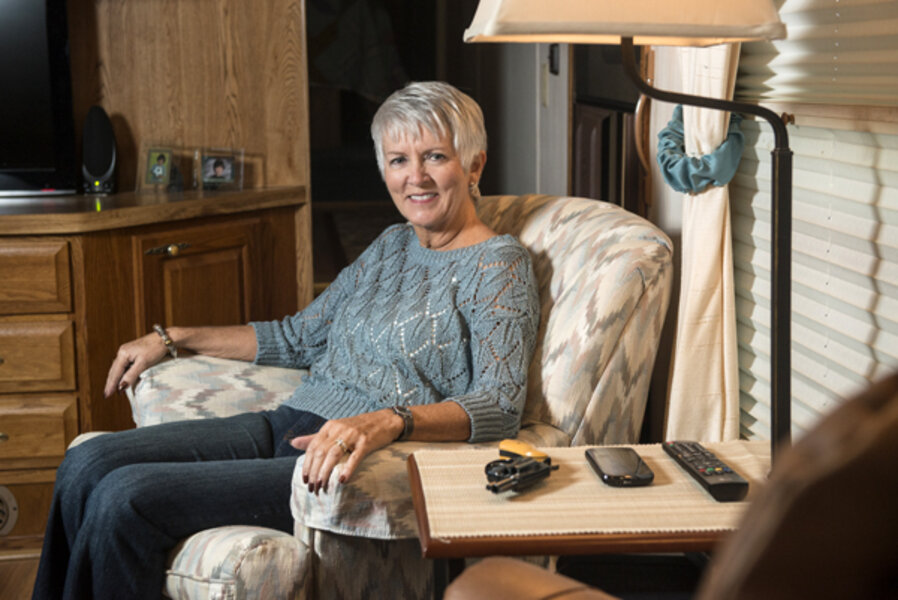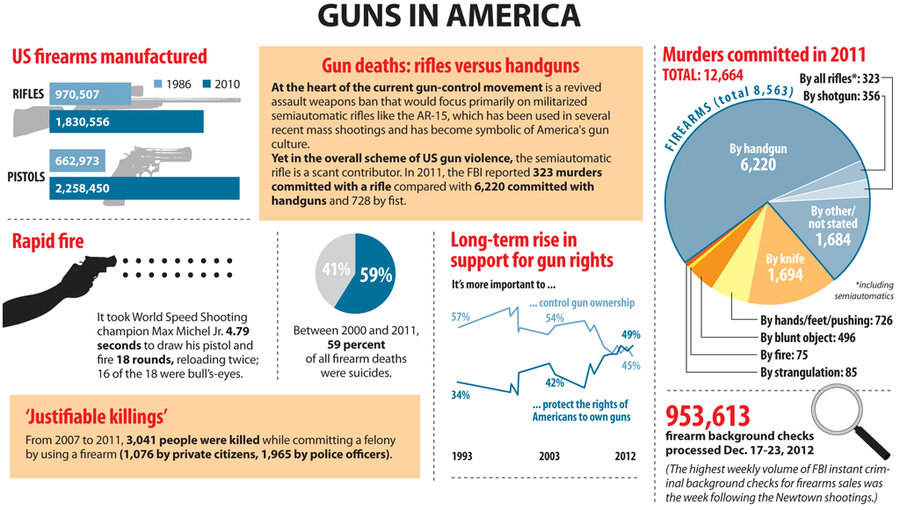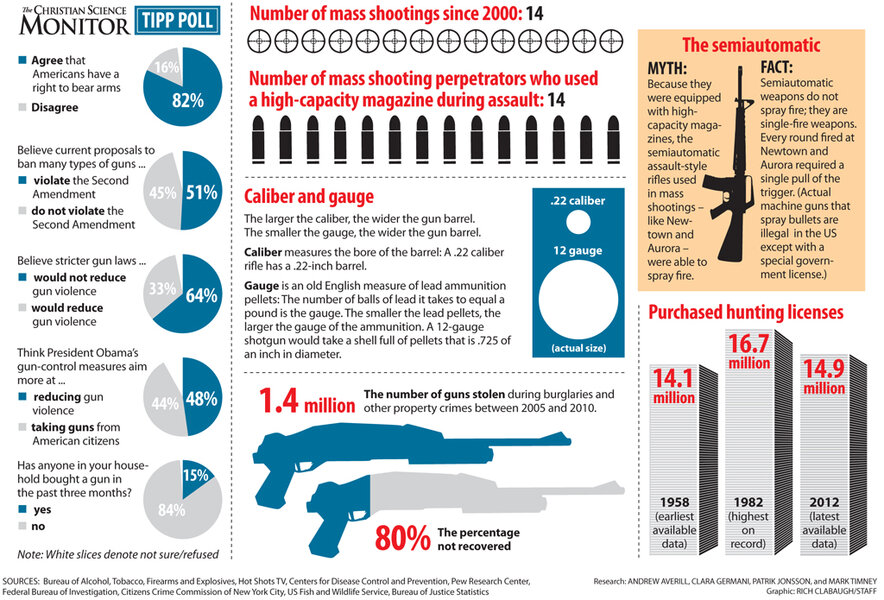Gun owners talk: Self protection is more complex than 'stand and fight'
Loading...
When hospital administrator Margaret Stroup heard the first eruptions of gunfire echoing down the scrubbed hallway outside her office, she knew immediately she was a target.
Armed with a semiautomatic rifle and pistol, a recently fired Soldotna, Alaska, hospital employee was hunting down five former bosses. In the chaos, as her former employee killed one of them on his way to her, Ms. Stroup felt drained of power: Normally a strong, take-charge woman, she felt a "cold paralysis" grip her.
"I knew I couldn't run ... there was no defense ... no way I could get away from that gun," she says of those minutes trapped in her office. She dropped behind her desk. After the gunman blasted through her door, she says, he came around the desk and pointed his rifle inches from her face to shoot.
But a bit of that strong Margaret Stroup was present: She swatted the barrel of the rifle as it went off, deflecting two rounds: one shot through her right breast and the other into her abdomen. She felt the ripple of the impact "vibration," but no pain; so, she says, after he left, "I got up and walked across the hall, and one of my staff got me to the emergency room."
After four years of healing – from the wounds themselves, post-traumatic stress, and a legal battle for compensation – Stroup still has trouble venturing out alone; much frightens her, from noises to crowds. "I'm afraid of someone taking out a gun," she says.
But she describes ways she's dismantling the fear, and one step Stroup has taken may seem counterintuitive: She bought a gun.
Even though the sight of a gun after the shooting made her shake, she now hopes that very thing will bring a peace of mind that will allow her to go out to a matinee with her grandchildren or to the grocery store.
"If I had had a gun, I would not have gotten shot. I don't think I would have frozen. I think the training to use that gun would have overrode the fear," Stroup says.
This is no knee-jerk conclusion; it's a rationale constructed through psychotherapy and soul-searching. Stroup – who calls her gun a "tool" rather than a "weapon" and sees pure logic rather than irony in her choice – believes it will reduce the fear that darkens her life.
Stroup's complicated experience may be unique, but her response is very American.
Owning guns for self-protection is a common American practice. A Gallup poll found in 2005 that in the 40 percent of American households that own a gun, 67 percent reported self-protection as a – if not the – reason. And in the immediate aftermath of the December Newtown, Conn., elementary school shooting, a Pew Research Center poll found that a slim plurality – 48 percent – of Americans think gun ownership does more to protect people from becoming victims of crime, while 37 percent say it does more to put people's safety at risk.
People who buy guns for defense range from victims like Stroup with hard-to-dispute evidence of a need for protection to those impressed by scary headlines. Some are better prepared than others to use them in real life.
Dave Young, whose company, ARMA Training – a part of the defense training Vistelar Group in Mequon, Wis. – provides military, law enforcement, and civilian firearms courses around the United States, has seen thousands of novice and expert students and estimates that 3 or 4 out of 10 in his civilian courses fail after he cuts through "all the fiction and fantasy" they bring with them. But Mr. Young does preach strongly the obligations a gun owner has – specifically, an exhausting list of lifestyle adjustments, including holster-accommodating wardrobe changes, how to sit, walk, and even hold a cup of coffee. And then there's the requirement to practice gun-drawing and shooting – in any number of possible positions – once a month. It's a regimen that would give pause to even the most avid gun enthusiast. (He details the just how hard the responsibilities are here.)
Often the decision to keep or carry a firearm for self-defense is emotion-based and not that well thought out, say many experts. The immediate formation of lines at gun stores after the Newtown shooting is an example.
"Fear makes people go out and buy a firearm," observes Young. "Fear makes them lose confidence in the lifestyle they had before, that gave them the feeling of being safe. However, this perceived safe lifestyle is not the environment they're in now."
But even aside from headlines like Newtown, the background noise of American culture is fear-inducing, says Dave Grossman, a former West Point psychology professor who wrote "On Killing," a study of the psychology of killing in war. Entertainment violence – from the endless loop of TV police dramas to video games, and even iconic movies like "Jaws" – creates a sense of a world of danger and a pervasive sense of fear, Mr. Grossman says: "Fear [in American society today] is at levels unknown in history."
'We are bad at judging risk'
The world may not be as dangerous as portrayed in the media. But, says Sam Harris, an author and neuroscientist who promotes secular values, even in what is probably the safest period of American history, "we are bad at judging risk. We are much more animated and frightened by dramatic events that are easy to remember and horrifying. A horrifying shooting like Newtown gets into our imagination."
Mr. Harris deems it "completely reasonable" to come down on either side of owning a gun for self-defense. But he suggests that "encountering violence is not as rare as many people imagine it to be." He has compared national FBI violent crime statistics with data for the relatively safe Beverly Hills, Calif., projected forward 30 years, and concludes that there is likely to be a violent crime for every 16 people in Beverly Hills, 1 for every 9 overall in the US, and 1 for every 3 people in sketchy urban areas. "That's not 1 in a million," he says.
Gun owners perceive their risks in different ways, but for many it's personal experience that governs a decision to use firearms for defense.
Miami attorney Scott Hidnert tells a harrowing tale of being chased by an armed robber in a parking lot one night in 2007. As Mr. Hidnert started his car, the masked man ran at him holding a gun; the attorney rushed his car to the security gate, but the gate opened too slowly.Hidnert reached into his glove compartment for his Glock pistol and jumped from the car to face the attacker, who was about 15 feet away; Hidnert shot several times, hitting him once and killing him. Police called it a legal use of lethal force. Hidnert now says: "I never thought I'd ever pull it out and use it. But now I keep it with me all the time. If I didn't have the gun, my children would be fatherless now. The gun saved my life."
Another father across the country in Longview, Wash., Ed Hunt, has a more reluctant resolve about guns as self-defense. "I've read the statistics, and I know violence has gone down," says the former journalist now working as an emergency room nurse. But "I have that sort of whiplash every day, being in my happy house and going to work where it's often violent."
He applied last month for a concealed-weapons permit after seeing enough threats in his environment to justify it, including violence he's seen in the emergency room, reported muggings outside the hospital, an unsettling experience with a menacing group of men when he was camping with his wife and two small children, and living in an isolated rural area far removed from law enforcement. He will buy a small pistol "as a last line of defense."
For another father of four children under age 7, Jim Irvine, the decision to carry a loaded pistol holstered on his hip nearly 24/7 is simple: What good is a gun in your bedroom if you need it when a "bad guy" is at the front door?
Mr. Irvine is a commercial airline pilot and the head of the Buckeye Firearms Association, which pays for firearms training for Ohio schoolteachers whose districts have requested it. He works hard to disguise the lumpy gun in an inside-waistband holster. But when people do find out he carries, he says they sometimes ask, "Are you paranoid?" He says his response is: "Are you paranoid because you wear a seat belt when you drive? It's just reduction of risk."
America's elephant in the room
Guns in the US can be "scary" for those who don't own or understand them, says Rose Everett-Martin, a mediator and handgun owner who is working on a civic dialogue program to find common ground on the issue in Butte, Mont. For Americans, she says, the use of guns "is [like] the elephant in the middle of the room for a family with dysfunction."
That dissonance is never far from those who have decided to bear arms for defense. Margaret Stroup is barely past the time she'd shake at the sight of a gun, and she was offended at the insensitivity of a man who recognized her and "walked up ... and introduced me to his wife as 'the lady that went to a gunfight without a gun.' "
Yet today, Stroup can articulate very clear reasons she thinks a gun will help her navigate her world.








